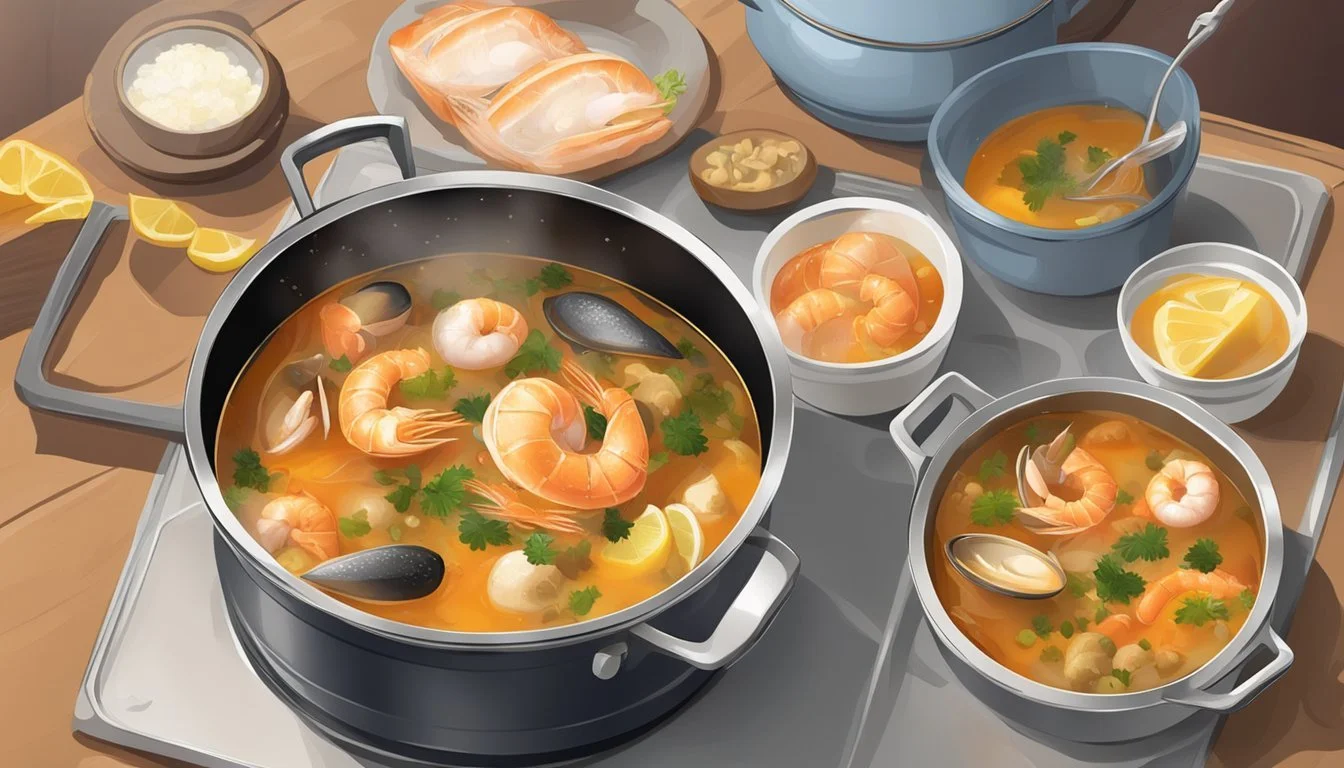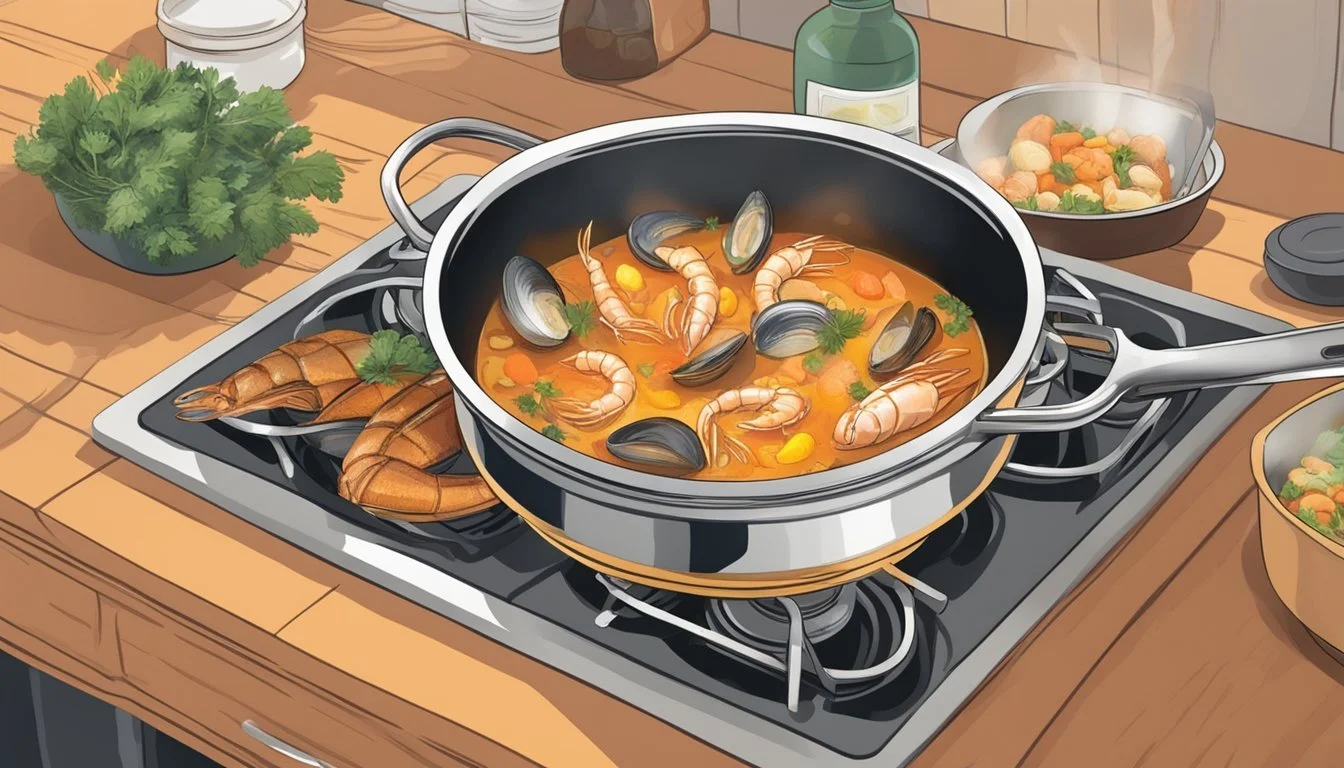Best Way to Reheat a Bouillabaisse
Ensuring Perfect Seafood Texture Every Time
Reheating a bouillabaisse, the traditional Provençal seafood stew, requires careful attention to preserve the delicate texture and flavor of the shellfish (What wine goes well with shellfish?) and fish within it. The complexity of its flavors, which are the result of a rich assortment of sea creatures, saffron, fennel, and a host of other herbs and spices, make it a dish best enjoyed fresh. However, it's not uncommon to have leftovers that one would want to enjoy the following day.
When it comes to warming up this French specialty, the key is in applying gentle heat to avoid overcooking the seafood (What wine goes well with seafood?). Since bouillabaisse is a medley of different seafood that often has varying textures and densities, a reheating method that distributes heat evenly without bringing the stew to a boil is preferred. This prevents the seafood from becoming tough and the flavors from becoming diluted.
A method that incorporates retained moisture, such as a low-temperature oven or a stovetop approach, can help maintain the integrity of bouillabaisse's ingredients. The goal is to bring the stew to a palatable temperature without compromising its signature quality, ensuring that each reheated serving is as satisfying as when initially prepared.
Understanding Bouillabaisse
Bouillabaisse is a traditional Provençal seafood stew renowned for its rich and complex flavors derived from a mix of fresh fish, shellfish, and distinct aromatics like saffron. This section will guide you through its key components and best reheating practices to maintain quality.
Ingredients of Bouillabaisse
Bouillabaisse combines a variety of seafood, including fish and shellfish, immersed in a broth that traditionally includes tomatoes, onions, and olive oil. Saffron lends the stew its signature intense color and part of its complex flavor profile.
Seafood: often a mix of white fish (What wine goes well with white fish?) and shellfish such as halibut, sea bass, or mussels (What wine goes well with mussels?)
Vegetables: typically onions, leeks, and tomatoes
Herbs: including parsley, thyme, and bay leaves
Spices: with saffron as an essential ingredient for authenticity
Complexity of Flavors
The flavor of bouillabaisse is robust, building a richness and depth that reflects the freshness of the ingredients. Olive oil emulsifies into the broth, creating a hearty base, while the spicy notes of saffron ensure a singular aromatic experience.
Food Safety Considerations
Proper storage is vital in preserving the quality and freshness of bouillabaisse, reducing the risk of foodborne illnesses. Refrigeration should be maintained at proper temperatures, and freezing is an option for longer storage, though it can alter the texture of the seafood.
Storage: below 40°F (4°C) for refrigerator, at 0°F (-18°C) for freezer
Shelf-life: 1-2 days in the refrigerator, up to 2-3 months in the freezer
Benefits of Proper Reheating
Reheating bouillabaisse correctly is crucial to maintain the succulence and tenderness of the seafood. Gentle reheating ensures the flavors remain complex and the texture of fish and shellfish is preserved. High-quality bouillabaisse benefits from careful reheating, as it revives the robust and rich character of the dish.
Preparation for Reheating
Proper preparation for reheating Bouillabaisse is crucial to preserve the quality and texture of the seafood within. Each step ensures that seafood, like fish, crab, shrimp, mussels, and clams, is reheated effectively to maintain its tenderness and moisture.
Thawing and Defrosting
Leftovers from a Bouillabaisse should be thawed gradually to prevent texture damage. One should transfer the leftover seafood from the freezer to the refrigerator a day before reheating to allow for slow defrosting. This mitigates the risk of freezer burn, ensuring that the delicate texture of seafood components is preserved.
Sectioning Seafood Components
Prior to applying heat, the seafood should be separated based on their individual reheating needs. Fish may require less time than shellfish such as crab, shrimp, mussels, and clams. Separating them ensures that each component is reheated to its optimal texture and avoids overcooking.
Preserving Moisture and Tenderness
When reheating, preventing moisture loss is key. One should cover the seafood with foil to trap steam and avoid dryness. Adding a small amount of water, fish stock, or butter beneath the seafood can provide gentle heat and keep it moist. It’s important to use just enough liquid to create steam, without submerging the seafood to maintain the desired consistency and flavor.
Reheating Methods Comparison
Choosing the right reheating method is crucial to maintaining the delicate texture of seafood in a bouillabaisse. Each method can affect the tenderness and flavor of the seafood differently.
Stovetop Reheating Technique
Stovetop reheating involves gently simmering the bouillabaisse in a pan. It is advisable to do this over low heat, which ensures that the heat distributes evenly without overcooking the seafood.
Simmer: Heat the bouillabaisse on low, stirring occasionally.
Pan: Use a heavy-bottomed skillet or pot to provide even heat distribution.
Oven Reheating Process
Reheating bouillabaisse in the oven is all about slow and steady warmth. The key to an even reheat is using a moderate temperature and covering with foil to retain moisture.
Temperature: Set the oven to a moderate temperature, around 325°F (163°C).
Bake: Cover the seafood with foil and reheat until warm throughout, approximately 10 minutes.
Microwave Reheating Considerations
Microwave reheating can be quick but requires close attention to avoid turning the seafood rubbery. Use a microwave-safe container and cover with a lid or plastic wrap to trap steam.
Even Distribution: Stir the bouillabaisse halfway through to ensure even heating.
Power Setting: Heat on a lower power setting and in short intervals, checking frequently.
Alternative Methods
Other methods like steaming and using an air fryer can also be effective. Steaming works by reheating the bouillabaisse in a pot with a steamer insert and a bit of water to generate steam. An air fryer can quickly reheat small portions with the benefit of a crispy finish on any previously fried seafood add-ins.
Steamer: Reheat with steam to keep seafood moist.
Fryer: An air fryer should be used carefully with precise timing to avoid drying out the food.
Adjusting Seasonings and Additives
When reheating bouillabaisse, adjusting seasonings and additives is crucial to revitalize flavors that might have mellowed. It's important to consider the balance of herbs, spices, and acidity to ensure the integrity of the dish.
Enhancing with Herbs and Spices
Herbs and spices are essential in bouillabaisse, bringing aromatic complexity and depth. Traditionally, saffron is non-negotiable, imparting an earthy warmth and signature color. Parsley, thyme, and bay leaves may also be used.
Saffron: Add a few strands to the reheating liquid to revitalize its color and flavor.
Garlic: Include a minced clove to infuse a subtle piquancy.
Fresh Herbs: Toss in parsley or thyme during the last minutes of reheating.
Pair herbs and spices thoughtfully with the fish and shellfish to maintain the integrity of the dish's flavors.
Balancing Acidity with Wines and Citrus
Acidity in bouillabaisse is not just a flavor enhancer; it's a pivotal component that cuts through richness and refreshes the palate. Properly adjusting the acidity ensures a balanced and bright profile upon reheating.
Lemon Juice: Sparingly add fresh lemon juice to provide a zesty lift.
Wine: Introduce a splash of a dry white wine or rosé when reheating to bring back the nuanced flavor without overpowering the dish.
Consider the wine pairing while reheating, as it should complement the bouillabaisse's profile. The rule of thumb is to use a wine in the dish that one would enjoy drinking alongside it. Ensure the wine selected is not too tannic, as it should harmonize with the seafood's delicacy, possibly opting for the very same bottle being served at the table.
Final Touches and Presentation
The key to presenting a revitalized bouillabaisse lies in attention to the seafood's succulence and the dish's rich complexity. It's crucial to showcase the quality and texture of the ingredients that comprise the seafood boil, ensuring a flavorful experience.
Serving Suggestions
When presenting the bouillabaisse, arranging the seafood on top of the broth can highlight its quality and texture. It's recommended that one gently place the pieces of fish, mussels, and other seafood on the surface of the warmed broth to maintain their succulence. To enhance the dish's aesthetic and flavor complexity, fresh herbs such as parsley or fennel fronds can be sprinkled on top. A light drizzle of high-quality olive oil just before serving adds a final touch, creating a visually rich and inviting dish.
Herb Garnishing: Parsley, Fennel Fronds
Oil Finish: Quality Olive Oil (Drizzle)
Pairing with Side Dishes
A bouillabaisse pairs wonderfully with simple yet flavorful side dishes. Consider serving it with a crusty loaf of French bread or garlic toasts that guests can use to soak up the flavorful broth. A side of roasted vegetables (What wine goes well with roasted vegetables?) can complement the heartiness of the stew without overshadowing its complex flavors.
Bread: French Bread, Garlic Toasts
Vegetables: Roasted Vegetables (Carrots, Potatoes, Bell Peppers)
The vegetables should be roasted until they have a bit of a char to add texture and a smoky counterpart to the fresh seafood. The pairing should respect the main dish, supporting but never competing with its rich and seasoned broth.
Storing Leftovers and Next-Day Tips
To ensure the quality and safety of bouillabaisse leftovers, one must adopt correct refrigeration methods, safeguard the seafood from air exposure, and apply gentle reheating techniques.
Refrigeration Best Practices
The key to maintaining the integrity of bouillabaisse leftovers lies in rapid cooling and storage at the correct internal temperature. Leftovers should be refrigerated within two hours of cooking to prevent bacterial growth. Food safety guidelines recommend:
Storing in shallow containers to expedite cooling.
Ensuring the refrigerator is at 4°C (40°F) or below.
Separating the seafood from the broth if possible to prevent it from becoming overly soft.
Sealing and Protection from Air
To protect the leftover seafood from air, the appropriate sealing method is critical. Exposure to air can lead to freezer burn if freezing and spoilage if refrigerated. Best practices include:
Using airtight containers or resealable plastic bags.
If freezing, press out as much air as possible before sealing.
Freezing is an option for extending shelf life, but may alter texture upon reheating.
Reheating Leftover Seafood Boil
When reheating a seafood boil, the aim is to restore the dish's warmth without overcooking the delicate seafood. It is important to:
Gradually reheat in a covered saucepan, stirring gently and checking for a uniform internal temperature.
Avoid using high heat as it can toughen the seafood.
Consider adding a small amount of liquid, like stock or the original cooking liquid, to keep the seafood moist.





